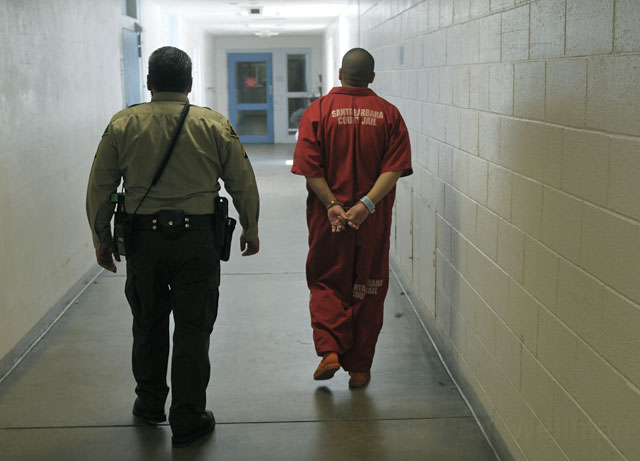Square Dance in a Mosh Pit
Jail, Probation Officials Struggle with New Convict-Placement Law

Close to 1,000 people live behind bars on a small hill above Turnpike Road. Some are convicted felons, many are small-time offenders, and others are accused criminals waiting for their day in court. All are packed into an outdated county jail with a 788-person capacity that divides volatile inmates by strict classification rules, but it watches as sentenced and un-sentenced inmates housed together naturally self-segregate along race lines and pecking orders, their numbers growing even greater in recent months.
On Tuesday, the County Board of Supervisors heard the latest report from Sheriff’s Department personnel and Probation Department officials on how AB 109 — the California law enacted in October that funnels prisoners and parolees into the care of local jurisdictions to alleviate pressure on the state prison system — is and isn’t working as planned.
Overall, S.B. law enforcement is dealing with around 25 percent more state prisoners than expected. Instead of the 180 people they thought would transition from state parole to county probation, 225 are now being monitored. Many were arrested for drug offenses, and a quarter wind up homeless when they leave custody. The projected number of 125 individuals who were expected to serve time in County Jail under new sentencing guidelines — nonviolent, nonserious convicts who would normally be incarcerated in prison — has jumped to an actual 189. “It’s a considerable increase in workload,” said Probation Department Chief Beverly Taylor. “It changes how business is done.”
During a recent tour of the County Jail, Lieutenant Timothy McWilliams with the Sheriff’s Department explained how an already volatile dynamic is made even more unstable by additional bodies being added to the maxed-out facility. When male and female inmates arrive, he said, they are interviewed while their criminal history is evaluated. Taking into account age, charges, gang affiliation, and other factors, they’re then housed in an area custody officials think will keep them and deputies the safest. “You try to put like with like,” he said. “It’s a big jigsaw puzzle.” In one area, white inmates could be seen playing spades while nearby a group of African-American men chatted. Latinos completed a calisthenics routine above them on the tier.
But should a bed become available in one of the cell blocks, it doesn’t necessarily mean it can be immediately filled, McWilliams said. Those charged with sex-related crimes or inmates who are testifying in criminal trials are often kept in protective custody, unable to mix with the general population. In addition to the jail’s basement and filing room that have been converted into inmate living space, said McWilliams, plastic shells lined with mattresses — called “boats” — often act as bedding in overcrowded wings. Newbies to the justice system sometimes struggle with what’s known as the “convict code,” he went on, which includes treating your “celly” with respect, flushing as you defecate, and adhering to unspoken workout and cleanup schedules. “Fights can happen anywhere, anytime,” he said.
A main point of discussion Tuesday was how state money and resources allocated to the county should be spent on inmate mental-health treatment and post-release care and programs. To date, only $32,454 of the $566,400 in state funding earmarked for AB 109–related mental-health and drug treatment services has been spent. Taylor explained that contracts with the area’s sober living centers have been hard to come by since many are already full. She said, however, that her department is actively reaching out to homeless support groups and that the probation unit will soon hire a staff psychiatrist.
As Sheriff Bill Brown works to secure another $20 million from the state to build a new jail — the county has already been given $60 million — Taylor and her team are crafting a budget report for the Board of Supervisors that will outline how the expected $7.6 million coming from California coffers for Santa Barbara’s AB 109 services will be spent in fiscal year 2012-2013.
Of the $3.7 million allocated for this fiscal year for extra jail costs, case management, electronic monitoring, and so on, just over $500,000 has been spent. Taylor said the slow expenditure is due to the learning curve of the new and untested AB 109 system. The extra cash will roll over into next year’s budget. County CEO Chandra Wallar, however, told the supes that state officials have been complimentary of Santa Barbara’s handling of realignment administration. Taylor and staff will be back in front of the supervisors on May 22 to present an updated spending plan after Governor Jerry Brown’s May budget revision is released by the 15th.



